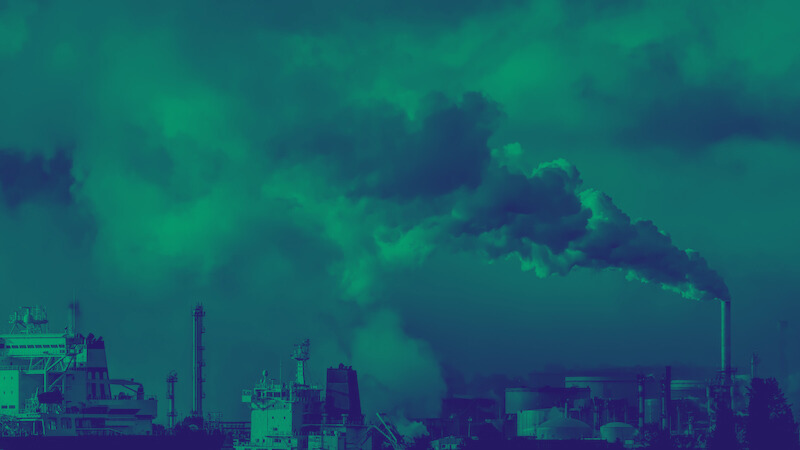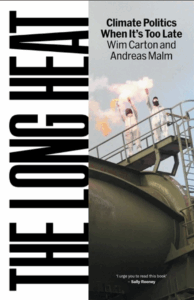
Carbon Offsetting is Not Going to Save the Planet
Wim Carton and Andreas Malm on Microsoft and the Big Business of Climate Indulgences
There is not enough planet Earth to first turn it inside out and then turn it outside in again. Available resources do not allow for removal of the total aggregate of CO2 from the fossil fuels in stock. Instead, removal should, for all the reasons we examined in the appendix of caveats, be conceived as a restricted practice, hemmed in on all sides by limitations—of energy, of land, of subsurface storage sites, of everything needed to get underway—more in the nature of advanced surgery than basic hygiene. A question then arises: what are we going to use it for? To what end should the precious removal capacity be deployed? If negative emissions technologies can indeed attain consequential scale, should they be pressed into the service of life extension for fossil capital?
Although they may serve that purpose already, even before they have entered the material world, the imminent risk is that, upon actual entry, they will be corralled into business-as-usual, as in DAC plants for enhanced oil recovery. Removal will then be negated into its opposite. This would be in accordance with the universal law of capital devouring everything potentially good and excreting it as something actually bad. Here the most egregious instance might be the use of removal to re-animate fossil fuel companies in general and enhanced oil recovery in particular, but there is something broader at work, which we might call late value form. In the overshoot conjuncture, capital seeks to press negative emissions technologies into the production of exchange-value. Against it stands any interest in deploying them for the use-value of reversal.
Here, then, is a second axis of contestation around negative emissions technologies: intersecting with late technopower is late value form. A concrete example would be communities protesting against projects for enhanced oil recovery. In Texas, Elida Castillo, a Latino environmental justice activist and community organizer, voiced dismay over the arrival of a DAC plant in her neighborhood: she and other residents were “worried about the dangers of storing CO2 where they live, the risk of new pipelines being built, and whether DAC is a good use of money in the first place. And there’s reason for distrust. After all, the DAC plant belongs to Occidental”: “ “You’re pretty much entrusting the bank robbers to guard the safe,” Castillo said.” Popular opposition focused on those projects both endangering their resources and enriching the very companies that fan the flames of heating.
But the state apparatus was of a different mind. Secretary of Energy Jennifer Granholm praised Oxy for “exactly the kind of bold thinking we need more of.” Her own thinking and that of Hollub—the secretary, the CEO— were in convergence. Months after the former took up her position under Biden, she asserted that “traditional fossil energy is going to remain important, even as we work to reduce carbon emissions”; echoing Nordhaus, “we’re also putting our brain power at the Department of Energy and our financial resources to work” on “approaches like direct air capture.” (“We need to extend the life of oil production,” maintained Hollub, because it “makes the world a better place.”) For its boldness, Oxy was awarded one of two major government grants for developing a “DAC hub,” in Texan oil country (the other went to Climeworks and Heirloom).
The cheque was for $500 million. The state also offered companies a tax credit, known as 45Q, for every ton of CO2 they grabbed hold of. For every ton, that is, they could apply for relief from tax payment, a form of indirect reward to (supposedly) green activities much favored by the American state. Under the first edition of Trump, companies would receive $50 per ton captured through DAC, even when it was utilized for enhanced oil recovery. Biden then raised this handout to $130. The “Office of Fossil Energy” under Granholm’s department was renamed the “Office of Fossil Energy and Carbon Management,” its mission redefined as “research, development, demonstration, and deployment to minimize the environmental and climate impacts of fossil fuel and industrial processes”—sewage as state ideology. This office celebrated an annual “Carbon Management Day,” as if to give the highest imprimatur to the ideas of a Lackner or a Keith. Support for late value form became a pillar of the climate politics of the Biden administration.
Meanwhile, the US “produces more crude oil than any country, ever,” the same state apparatus proudly announced, the curve steadily rising under Biden, new records forecast—for oil and gas—in 2024 and 2025, no end in sight. With the various boons, his administration might have also created the condition for a boom in enhanced oil recovery, similar to the earlier one in fracking. Possibly of even greater moment, it locked the development of DAC technology into late value form. “These hubs are going to help us prove out the potential of this game-changing technology so that others can follow in their footsteps,” exulted Granholm; they would “position the United States as the location to demonstrate the commercial viability of direct-air capture,” concurred Hollub. The program, was explicitly conceived to help midwife DAC in the US and the rest of the world. If successful, this productive force— supposed to be restorative, in at least some visions—would grow up in symbiosis with primitive fossil capital. Client states of the hegemon, such as the UAE and Saudi Arabia, readied themselves to assist in the upbringing.
Approaching 1.5°C could seem like a moment without precedent. But the world had ended up there by passing through an unbroken series of decisions not to cut emissions and to do something else instead; and this practice had become so habitual and systemic as to threaten to determine the next phase too.
How would this nestling fare under the second Trump? In early 2025, no one could say with any certainty; consistency and predictability were not among the primary qualities of this president. Employees at the Office of Fossil Energy and Carbon Management responsible for removal were laid off and payments to DAC hubs frozen—not necessarily because of any Trumpian antagonism towards these technologies as such, but because of the way he and Musk set their wrecking balls working on the state apparatus. This could hollow out support mechanisms. But Hollub, for one, was not losing any sleep over it. If DAC could provide the lubricant to keep the country’s oil wells productive a good while longer, then even the 2025 version of Trump should love it—indeed all the more so. It would help him get that liquid gold from under his feet.
“President Trump knows the business case for this. I’ve had several conversations with him,” Hollub assured a group of slightly jittery investors. In fact, “I think the election of Donald Trump to become our next president is going to be very positive for our industry, especially for our direct air capture.” Perhaps it would do some good for BECCS too. Trump’s secretary of the interior was Doug Burgum, previously the governor of North Dakota. He was “obsessive about carbon capture” and “the technology’s chief evangelist” in that state. Burgum was a staunch advocate of the Midwest Carbon Express, the misunderstood CO2 pipeline. He thought it offered beguiling economic opportunities, not least because the substance it carried could bring new life to North Dakota’s aging fields of shale oil. Nothing could be more indicative of the nature and power of late value form than the prospect that even the most unashamedly denialist administration might jump onto its bandwagon.
But late value form extended far beyond such cartoonishly ghoulish companies as Oxy and Exxon and Aramco. No less prominent was the later crop of digital enterprises with an enlightened mien: Microsoft, Amazon, Google, Meta, Shopify. How did they inject removal into their veins? Through offsetting, of course. This practice had its own history, another tributary to the overshoot conjuncture that weighed heavily on its future course. Indeed, the currents and sheer force running through this stream might well sweep up the technologies launched in the 2020s, because it had already done so several times before. Approaching 1.5°C could seem like a moment without precedent. But the world had ended up there by passing through an unbroken series of decisions not to cut emissions and to do something else instead; and this practice had become so habitual and systemic as to threaten to determine the next phase too.
A short story starring Microsoft
By the early 2020s, the removal business was structured by the logic of offsetting through and through. In the Cambrian explosion of technologies, the startups taking them to the market competed for survival by selling credits. Fledgling entrepreneurs fell over each other to position themselves as the vendors of the newest, hottest, most effective, most trustworthy certificates of removed CO2. Insofar as these were purchased by consumers with an interest in glossing over an actual release of that gas, no net removal would happen: through the transaction, the –A would simply be matched with +A, in a zero-sum game that could not possibly power reversal. It would at best be running to stand still.
This lapse into the default of offsetting was not the result of evil design, nor was it a cover-up of the sort pathological sex addicts might engage in. It was the result of a structural imperative, namely the commonplace market imperative: a producer of removal had to sell their product on the market or else go under. Buyers would, by definition, be the source of demand. Only one other scenario could be dimly made out in the distance: governments stepping in and funding removal out of collectively pooled resources, for its own sake. Until that day, the business would have to be mediated through the market and run the risk of descent into late value form.
Consumers entering this marketplace could pick up the catalogue and browse: fancy some credits from Living Carbon and its genetically modified poplars? Or perhaps feces from Vaulted Deep, seaweed from Running Tide, rocky dust from Lithos, or the latest squishy white balls from Spiritus? Here the most enthusiastic customers often came not from primitive fossil capital but from fossil capital in general—companies not producing but consuming fossil fuels in the process of money-making and wishing, for whatever reason, to even them out with credits. One customer was in a league of its own: Microsoft.
By the early 2020s, the market had been conceptually divided between “durable” removals—the high-end niche, the hard diamonds of the bazaar: CO2 supposedly stowed away permanently through DAC, BECCS, enhanced weathering, biochar—and those with a reputation for ephemerality, notably trees: the variety store. The market for durables appeared to be booming, from close to zero in 2020 to 134 companies peddling their goods in 2024. On the side of the buyers, as of that year, the market was Microsoft: it alone bagged almost two thirds of all credits sold. The proclivities of this company might have stemmed from its founder Bill Gates, long worried about the state of the world, an early benefactor of the startups—including Carbon Engineering— author of How to Avoid a Climate Disaster: The Solutions We Have and the Breakthroughs We Need; to sum up his CV, the late human face of capitalism. He personified all the usual characteristics of overshoot ideology: the transition is bound to be gradual, and it can only ever be incomplete. “There are no realistic paths to zero that involve abandoning these [fossil] fuels completely,” and so instead, the future we face is one in which “we will still be producing some emissions, but we’ll have some ways to remove the carbon they emit.” Under his spiritual leadership, Microsoft went on a shopping spree.
One mega-purchase followed another. In May 2024, Microsoft publicized the single largest transaction on this market, until that point: a deal with Stockholm Exergi for the delivery of credits from its future BECCS plant. The tech giant would thereby “obtain legal title to those removals,” in its own words (ecocapitalist outlet GreenBiz filed the news under the category “Practical Magic”). This followed a mega-purchase from Danish energy company Ørsted, which also promised to operate a BECCS plant in the near future and have the CO2 shipped to the Northern Lights. Then came a deal with 1PointFive to buy credits from Stratos—the largest sale of DAC credits thus far. Unlike Oxy’s other plans for that plant, the CO2 removed under Microsoft’s patronage would be “securely stored through subsurface saline sequestration and will not be used to produce oil and gas.” Microsoft was a believer. “We believe that the time for responsibly scaling BECCS is here and look forward to the coming wave of project developments.” “DAC plays an important role in Microsoft’s carbon removal portfolio.” But Microsoft was a promiscuous shopper; it also bought credits from Lithos and, not as durable, forests in countries like India, Brazil, Peru. What for?
In January 2020, on the crest of the wave of popular mobilizations for the climate, Microsoft made a sensational announcement: it would become “carbon negative” by 2030. After that date, it would remove more CO2 from the atmosphere than it emitted, to the point—scheduled for 2050—when there would no longer be any molecules attributable to it. All the company had emitted since Gates founded it in 1975 would be gone, the full footprint washed away. The communiqué earned a tremendous amount of positive press. Stories included lines such as the following. “The thing about Microsoft’s work that I love, love, love is the investment in climate equity and environmental justice. This has been missing from the corporate dialogue.
More companies should take this kind of intersectional lens.” Microsoft claimed to have been “carbon neutral” since 2012, thanks to its spendthrift purchasing of offsets; now it would raise the bar and go flat-out negative. This was indeed something new under the bourgeois sun. Never before had a company—and not any company: one of the largest capitalist corporations on Earth; by some counts, the largest—pledged to undo the totality of the harm it had inflicted on the climate system. It would do so of its own volition, no government interference needed. It was about to set an example for the rest of humanity to follow—maybe all the way back to a pre-capitalist climate.
About midway into the decade that would turn Microsoft negative, a bit of a hiccup was reported. By its own admission, the company’s emissions were 29 per cent higher four years into the decade than at its start—up nearly by a whopping third, that is. This was not quite the example for humanity, nor the route that led to negativity. Nothing indicated that the removal credits Microsoft was snapping up were enough to cancel out these emissions, let alone surmount them. At the very best, it was now operating within the fourth configuration of continue and ameliorate—at most the credits offset a fraction of the gush. One driver was all the energy and steel needed for the ever-growing data centers, courtesy, in part, of the AI boom. That boom looked like it would largely be powered by newly constructed gas plants. But the problem went beyond the fossil fuels Microsoft burned within its own process of producing profit, and indeed those consumed by individuals using its software. Few clients of this company were as weighty as the fossil fuel companies themselves.
Microsoft was plainly not about to wash away its own or anyone else’s footprint. Indeed, emissions from the fossil fuels it helped bring to the surface were not even counted among those it wished to neutralize and remove.
The overshoot conjuncture coincided with a major thrust towards digitalization, computerization, automation of oil and gas extraction: and Microsoft was the supplier second to none. In 2020, Barclays published a report lauding the advances of cloud services, AI, machine learning, remote sensing, edge computing and related technologies into the oil and gas fields of the world, speeding up discoveries, optimizing the location of wells, maximizing recovery rates, improving throughput in pipelines and so on and so forth: through the digital nostrils, yet another breath of life into primitive fossil capital. It would cut costs and increase production and, summum bonum, raise profits. “Big Tech has made a big push into the Oil & Gas sector,” noted Barclays, and “Microsoft has been the most aggressive, saying that Oil & Gas is the #1 growth market for its cloud services”; and true to form, “Microsoft has become the cloud server of choice for the industry.”
A particularly rewarding product was the cloud computing platform Azure. Just as Microsoft prepared to go negative, it entered a series of highly durable deals with ExxonMobil, Chevron, Equinor, Halliburton, Schlumberger, Petrofac and other heavyweights for integrating Azure into their operations. Microsoft went to the Gulf, to an exhibition hosted by ADNOC, and gave its pavilion the theme “Empowering Oil & Gas with AI.” In the very week when the company made the “moonshot” announcement about going negative, it took center stage at an expo on a similar theme hosted by Aramco. Had it changed its mind?
Two years after the announcement, Microsoft confirmed that it would continue to sell its commodities “for subsurface exploration and extraction of fossil fuels.” In 2023, the chief technical architect at its center in Houston posted a gushing accolade to the industry—always “at the forefront of innovation, constantly pushing the boundaries of what’s possible”—and now, thanks to his own company, once more “unlocking previously inaccessible reserves.” “With Azure, the future of oil and gas exploration and production is brighter than ever.” By this point, some employees were so disgusted by the hypocrisy that they quit their jobs. Microsoft was plainly not about to wash away its own or anyone else’s footprint.
Indeed, emissions from the fossil fuels it helped bring to the surface were not even counted among those it wished to neutralize and remove. In the material world, this company reinforced the wall blocking every path to climate stabilization. By selling means of production to primitive fossil capital, Microsoft profited from the tendency of fixed capital to rise in extraction and built up more assets that must not be stranded: for every mega-purchase of Azure sunk into a field, the incentive grew to keep the oil gushing. No BECCS from Stockholm or DAC from Texas could come close to offsetting this propagation of business-as-usual.
But Microsoft might indeed have set the standards for what other tech companies were expected to do, even if they lagged behind. Shopify stood behind the united Frontier. Like most others, it nominally stuck to the principle of first reducing emissions and then adding removal to go the extra mile. Like Microsoft, it was, in fact, rapidly increasing emissions, mainly by encouraging its employees to fly between offices. But Shopify claimed that its bag of removal credits offset all the emissions from delivering commodities on Black Friday. Google was another regular in the malls of removal. It was a heavy consumer of Indian biochar, Brazilian rock dust, bio-oil charms and DAC credits from a new startup called Holocene (time machine as trademark). But it too was riding an AI wave that caused its emissions to curve steeply, by almost 50 per cent since 2019—in the direction opposite, of course, from reduction. It was happily publishing greenwashing ads by oil and gas companies on its various platforms.
Among its prominent cloud computing customers was Saudi Aramco. Alongside Google, there was JPMorgan, which invested in Frontier, and in Climeworks, and in forests; and, in every year after the Paris Agreement save one, it was the bank that poured the most money into fossil fuel projects. Even the emissions intensity of its investments was headed upwards. (“We are thinking about commercial value, it’s not for philanthropic purposes only that we buy carbon removal. From a reputation perspective, it brings value to our brand. Our customers expect us to do it,” explained the head of “carbon management” at JPMorgan.) Another proud backer of Frontier was number one consulting firm McKinsey; and it continued to work tightly with clients like ExxonMobil and Aramco and allied with Sultan Al Jaber to temper ambitions at COP28. The same BlackRock that lifted Stratos off the ground was perfectly clear about its intention not to stop investing in fossil fuels, now or in the future.
Then there was Elon Musk, who, with his XPrize Carbon Removal, preened in more stardom and pioneership than most. His uncompromising commitment to removal was plastered in large, capital letters on the website of the Prize: “We want teams to build real systems that can make measurable impact at a gigaton level. Whatever it takes. Time is of the essence.” In an interview carried out around the time the Prize was announced, he professed his concern that “there is some risk of non-linear climate change” and it would be “not wise to take” that risk. But as part of his rightward drift, he also told a festival organized by the far-right Brothers of Italy that “climate change is exaggerated in the short term” and “we should not demonize oil and gas in the medium term.”
In 2024, he shoveled a few hundred million dollars into denialist-in-chief Donald Trump’s second run for president. In a candid chat between the two billionaires—described as “the dumbest climate conversation of all time”—Musk shared with Trump his views on the climate crisis. Now time was no longer of the essence. “We don’t need to rush and we don’t need to like, you know, stop farmers from farming or, you know, prevent people from having steaks or basic stuff like that.” More concerned about peak oil than an overheating planet, Musk went on to explain that CO2 concentrations would only become a concern around 1,000 ppm, when “it actually simply gets uncomfortable to breathe” and “you start getting headaches and nausea.”
The bromance continued inside the White House, where Musk and Trump together rolled back whatever little progress the Biden administration had made on climate and then rolled some more. Tangled and twined though it might seem, there was a thread running through this performance. For all his apparent schizophrenia, Musk embodied a key feature of overshoot ideology: there was no inherent contradiction between denying the depth of the climate problem and posing as the über-patron of innovations for removal. The two themes could play a perfect symphony. All one had to do would be to rethink what removals are for (or shake off any post-substitutionist illusions about it).
As part of Musk’s rightward drift, he also a festival organized by the far-right Brothers of Italy that “climate change is exaggerated in the short term” and “we should not demonize oil and gas in the medium term.”
The black hole of fossil fuels was not, in other words, only expanded by the likes of Oxy. Everything else was affected by its gravitational pull and drawn into the work of dilating it further—even the firms rumored to be at the farthest remove from the crudity, even negative emissions technologies and the market on which their credits circulated. The ecumenical engagement with removal merely confirmed the integration between primitive fossil capital and every other circuit of accumulation. Vicky Hollub and Bill Gates were bedfellows (as evidenced by their shared interest in Carbon Engineering). From their respective sides, they pulled removal into late value form—which, it is important to repeat, functioned through ideology as much as through processes of production. Gates did not get any directly enhanced oil, like Hollub. But he and Microsoft earned a first-class reputation.
Everything is unavoidable
In these days of net zero, there was an added rationale for removal: some emissions were “unavoidable.” Or, they were “residual” or “hard to abate”—however one chose to put it, impossible to do without. To get to zero, they would have to be effaced by negative emissions of the same magnitude. This line of reasoning had the formal seal of approval from the IPCC; indeed, it was one justification for removal in the IAMs. But what, really, was unavoidable? IPCC models typically left a rump of 20 per cent of current emissions in this category, after the rest had been mitigated—one fifth, that is, would have to remain in effect and balanced out by removal (over and above any return assignment). Countries were betting on roughly the same amount in the plans they submitted to the UN; but their assumptions and definitions and interpretations of “residual” were all over the place.
The International Energy Agency turned out to be less resigned to the things that exist and capped this class of emissions at 5 per cent. Companies themselves worked with everything from 0 to 80 per cent; Microsoft’s hypothetical decarbonization pathway appeared to count on close to 50. The extent of the unavoidable seemed to be in the eye of the beholder. In a world overstocked with assets at risk of being stranded, the temptation to classify emissions as “unable to be prevented or stayed away from”—the meaning of “unavoidable,” according to the Cambridge Dictionary—seemed plain as a pikestaff. There was something arbitrary about the way this term and its synonyms were bandied about. Unless the category could be brought under control, the excess threatened to self-propagate.
The more removals used for offsetting, the less available for reversal. Late value form becomes the underwriting of luxury.
One solution was to reserve the category for a select few sectors: agriculture (think methane from cows or rice paddies), aviation, shipping, cement, petrochemicals—all difficult to disconnect from emissions, on the common view. (We discussed several of these in Overshoot.) However great the difficulties, they did not shrink with the common assumption that said sectors would continue to grow. This led to the slightly absurd belief that the cumbersome category of unavoidability was itself inexorably growing: not only could the world not help emitting a great deal, it also could not help doing it ever more. Many things were here naturalized at once. Take aviation, for instance. It was the prototypical member of the residual club: people want to fly; planes run on jet fuels; there are no substitutes at hand; hence these emissions must be accepted—their growth to boot—and treated by means of removal.
But consider again Bill Gates. He was a very frequent flyer. He owned a private jet, a Bombardier BD-700 Global Express, complete with a salon of discreetly beige seats. In 2017, he took sixty flights and left a plume of more than 1,600 tons of CO2 in his wake. This gave Gates, from the use of his private jet alone, the same carbon footprint as a small town in Burundi. He did not think this was a problem, because Bill Gates was an avid investor in removal and devotedly offset his sins with credits. He bought them from Climeworks— indeed, he boasted of being its largest individual customer.
On the generally accepted logic of unavoidability, Gates’s flying emissions would fall in this inviolable category. This one billionaire would thereby be entitled to a disproportionate share of—remember, by nature limited—removals, simply by virtue of his ability to pay handsomely for them. No impoverished peasant or worker in, say, Benin or Belgium could do such a thing: these folks did not fly very frequently, if at all; hence they produced no unavoidable emissions; hence negative emissions technologies need not be hitched to their lifestyle. If it were up to the market to allocate unavoidability and the removal conjugated to it, such technologies would by definition flow towards actors with money— aka the heaviest polluters. What removal society could afford would be set apart to compensate for the emissions from the Bill Gateses of this world, while “displacing needs from sectors with high public value but limited private ability to pay (for example, farming, remote hospitals)”—or, what rice farmer in Bangladesh can buy credits from Climeworks?
Insofar as it is left to the invisible hand to arrange these matters, this scenario seems truly unavoidable. A billionaire has greater purchasing power than a Bangladeshi laborer and will be able to claim more removal capacity—so much capacity not used for subsistence or survival, including return from overshoot. The more removals used for offsetting, the less available for reversal. Late value form becomes the underwriting of luxury.
_________________________________________

From The Long Heat: Climate Politics When It’s Too Late by Wim Carton and Andreas Malm. Used with permission of the publisher, Verso Books. Copyright © 2025.
Wim Carton and Andreas Malm
Wim Carton is Associate Professor of Sustainability Science at Lund University, Sweden. He's the author of over 20 academic articles and book chapters on climate politics. His work has appeared in top journals such as Nature Climate Change, WIRES Climate Change and Antipode. Andreas Malm is Associate Professor of Human Ecology at Lund University, Sweden. He is the author of several acclaimed books, such as, with the Zetkin Collective, White Skin, Black Fuel: On the Danger of Fossil Fascism. His book How to Blow Up a Pipeline is an international bestseller and has been turned into a feature film.












